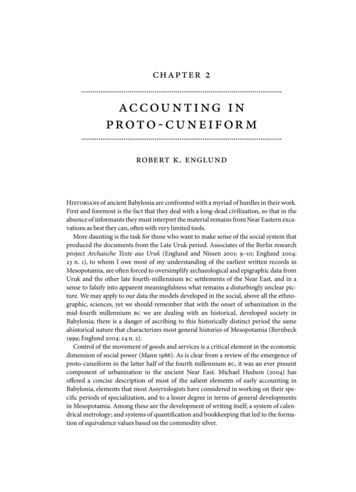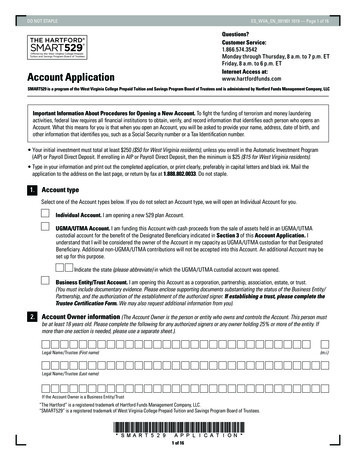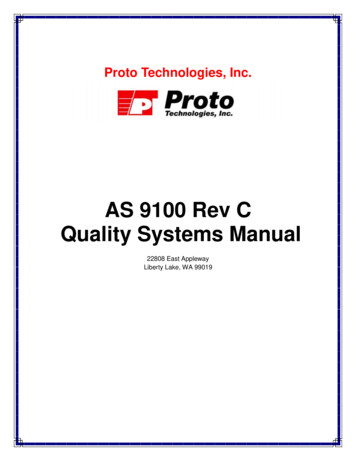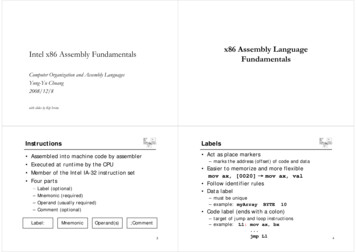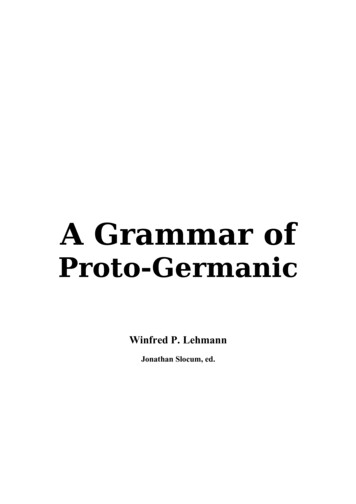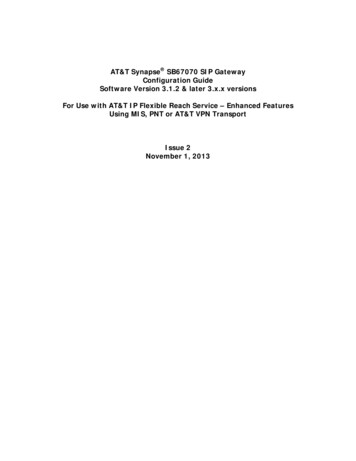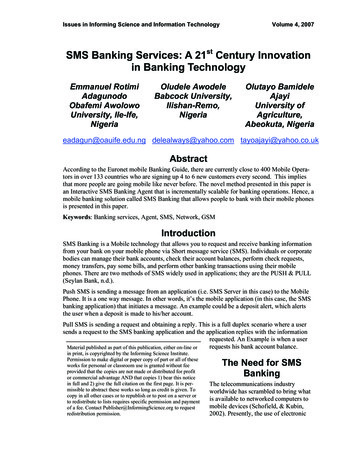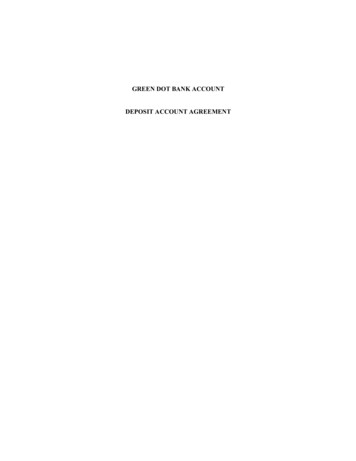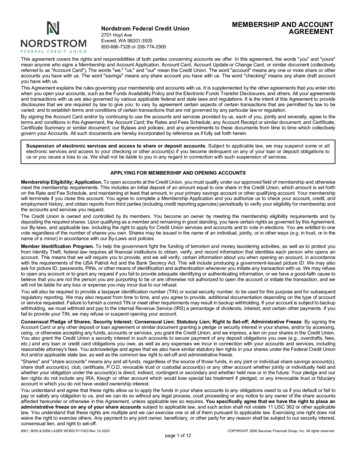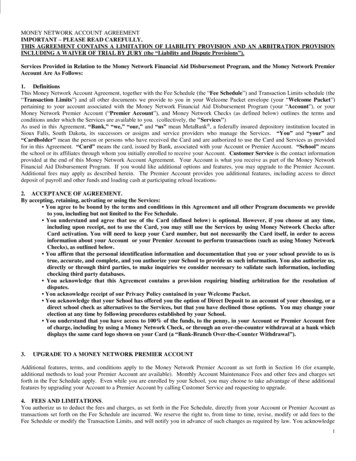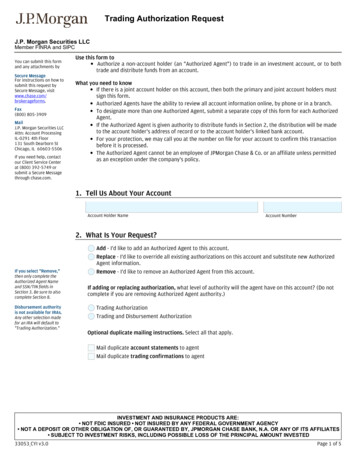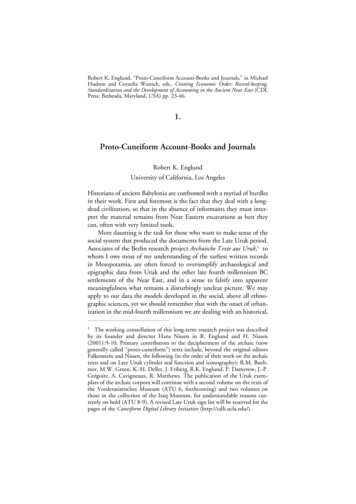
Transcription
Robert K. Englund, “Proto-Cuneiform Account-Books and Journals,” in MichaelHudson and Cornelia Wunsch, eds., Creating Economic Order: Record-keeping,Standardization and the Development of Accounting in the Ancient Near East (CDLPress: Bethesda, Maryland, USA) pp. 23-46.1.Proto-Cuneiform Account-Books and JournalsRobert K. EnglundUniversity of California, Los AngelesHistorians of ancient Babylonia are confronted with a myriad of hurdlesin their work. First and foremost is the fact that they deal with a longdead civilization, so that in the absence of informants they must interpret the material remains from Near Eastern excavations as best theycan, often with very limited tools.More daunting is the task for those who want to make sense of thesocial system that produced the documents from the Late Uruk period.Associates of the Berlin research project Archaische Texte aus Uruk,1 towhom I owe most of my understanding of the earliest written recordsin Mesopotamia, are often forced to oversimplify archaeological andepigraphic data from Uruk and the other late fourth millennium BCsettlements of the Near East, and in a sense to falsify into apparentmeaningfulness what remains a disturbingly unclear picture. We mayapply to our data the models developed in the social, above all ethnographic sciences, yet we should remember that with the onset of urbanization in the mid-fourth millennium we are dealing with an historical,1The working constellation of this long-term research project was describedby its founder and director Hans Nissen in R. Englund and H. Nissen(2001):9-10. Primary contributors to the decipherment of the archaic (nowgenerally called “proto-cuneiform”) texts include, beyond the original editorsFalkenstein and Nissen, the following (in the order of their work on the archaictexts and on Late Uruk cylinder seal function and iconography): R.M. Boehmer, M.W. Green, K.-H. Deller, J. Friberg, R.K. Englund, P. Damerow, J.-P.Grégoire, A. Cavigneaux, R. Matthews. The publication of the Uruk exemplars of the archaic corpora will continue with a second volume on the texts ofthe Vorderasiatisches Museum (ATU 6, forthcoming) and two volumes onthose in the collection of the Iraq Museum, for understandable reasons currently on hold (ATU 8-9). A revised Late Uruk sign list will be reserved for thepages of the Cuneiform Digital Library Initiative (http://cdli.ucla.edu/).
24R.K. ENGLUNDdeveloped society in Babylonia; there is a danger of ascribing to this historically distinct period the same ahistorical nature that characterizesmost general histories of Mesopotamia.2Control of the movement of goods and services is a critical elementin the economic dimension of social power.3 As is clear from a reviewof the emergence of proto-cuneiform in the latter half of the fourth millennium BC, it was an ever-present component of urbanization in theancient Near East. M. Hudson has offered in the introduction to thisvolume a concise description of most of the salient elements of earlyaccounting in Babylonia, elements that most Assyriologists have considered in working on their specific periods of specialization, and to alesser degree in terms of general developments in Mesopotamia. Amongthese is the development of writing itself; a system of calendricalmetrology; and systems of quantification and bookkeeping that led tothe formation of equivalence values based on the commodity silver.Considering the importance of precious metals in most early civilizations, it might seem surprising to learn that we have no clear evidencein the archaic texts of the use of weights, nor any evidence that silverwas in any way used in early households in a manner comparable tolater, third millennium usage. We indeed are hard pressed to cite evidence for the utilization of equivalence values in the Late Uruk period,with the possible exception of ration days.An attempt is made in the following pages to give a general impression of the little we know about the accounting methods in the archaicperiod, with occasionally formalistic information culled from earlytexts, starting with a review of the development of writing; discussingin short fashion the importance of archaic numerical and metrologicalsystems as elements of social control; illuminating the use of writingwith some examples drawn from grain administration archives;touching on the matter of labor management; and closing with a tentative discussion of the implications the labor accounts have for ourunderstanding of archaic ideology of class.2This is a criticism of most integrative treatments of early Mesopotamia. Fora recent example see R. Bernbeck’s 1999 review of M. Van De Mieroop’s TheAncient Mesopotamian City, in which he describes the author’s proclivity of distilling into a homogeneous Babylonian community what must have been adeveloping social construct through time and space.3 See the discussion by M. Mann (1986).
PROTO-CUNEIFORM ACCOUNT-BOOKS AND JOURNALS25Account-keeping and the emergence of writingMore so than other writing systems, cuneiform has been described as ascript based on a long history of preliterate accounting devices. Mostwho have studied the matter have considered early writing to be a collateral development from the exploitation of an increasingly complexmethod of fixing quantitative data.Urbanization in southern Babylonia during the Middle and LateUruk periods resulted in the growth of the settlement of southernMesopotamian Uruk into an expanse of 200 hectares, with a population estimated to have approached 40,000 or more. Very large numbersof this population evidently were available for the construction andmaintenance of the massive public district known as Eanna, with itsmonumental architecture surely the clearest testimony to the extraordinary new surplus economy supporting Uruk.Hand in hand with these urban developments are found in thearchaeological record a series of accounting devices known popularly as“tokens” since the publications of Schmandt-Besserat. While the TexasPeriodLate Uruk3200Archaic texts from Uruk:Writing Phase Uruk IV,Writing Phase Uruk III3100300029002400First urban centersJemdet NasrEarly Dynastic IArchaic texts from UrFormation of largeirrigation networksEarly Dynastic II26002500Beginning of large-scalesettlement of BabyloniaAge of early civilization28002700Historical DevelopmentsClay bullae andnumerical tablets34003300Writing PhaseTexts from FaraEarly Dynastic IIIRival city-statesOld Sumerian textsFigure 1: An overview of the chronology and historical developments of theearliest literate periods in Babylonia.
26R.K. ENGLUNDarchaeologist has been faulted for over-interpreting both the systematization and the iconic differentiation of these small clay objects,4 therecan be little doubt that at least a subset consisting of many of her simplegeometrical artifacts represents the precursors of writing in Mesopotamia, and therefore that cuneiform began with numerical signs.This assertion is based on two phenomena. First, the simple tokenswere gathered in discrete assemblages and encased in clay balls in theperiods immediately before the emergence of proto-cuneiform ca. 3300BC, and these balls were then sealed with impressions from cylinderseals– the hallmark of 3000 years of Babylonian administrative history.Second, the plastic tokens were themselves impressed on the outer surfaces of some balls, leaving marks which, both physically and also intheir context, conform exactly to the impressed numerical signs of theearly so-called numerical tablets and the curvilinear tradition ofBabylonian accounts down to the Ur III period at the end of the thirdmillennium. We have little doubt that a statistical analysis of the overbearing numbers of tokens still encased within clay envelopes wouldlead even further, to the establishment of the preliterate use of numerical sign systems with the same abstraction of unit bundling as has beenshown for proto-cuneiform numerical notations. We should anticipatethat we will find the two most important numerical systems in thesetokens, one used to count discrete objects and one used to quantifycapacity measures.It is of historical interest that the so-called Uruk expansion continued down through the use of bullae and sealed numerical tablets.Further, as R. Dittmann demonstrated at the Tübingen conference onthe Jemdet Nasr period, this contact continued into the earliest phaseof “ideographic” inscriptions of the Late Uruk period, those that I havecalled the numero-ideographic tablets.5 These texts from the Susa level4Her publications have been conveniently consolidated into a two-volumework Before Writing (Austin 1992), itself reprinted in an abbreviated version,How Writing Came About (Austin 1996). Specialist reviewers from the fieldsof Near Eastern archaeology and Assyriology have not been kind to the scholarship represented by this work, while it has received a generally positive pressfrom non-specialists, and as is evident from its wide publicity, from scienceeditors of leading media organizations.5 R. Dittmann (1986):332-66; R. Englund (1998):51-56.
PROTO-CUNEIFORM ACCOUNT-BOOKS AND JOURNALS27Figure 2: Schmandt-Besserat’s writing history17Ax “contact”6 correspond nicely with texts found in the area of theRed Temple at Uruk, characterized by their inclusion of seal impressions, numerical notations and one or at most two apparent ideogramsrepresenting the basic agricultural commodities: butter oil, textiles andsmall cattle.6See P. Damerow and R. Englund (1989):15 n. 37. This artificial stratigraphic construct of Dyson, Le Brun and Dittmann has not been proven byexcavations of Susa, nor evidently can the epigraphic finds from the area of theRed Temple in Uruk serve to strengthen the argument for a linear development, from numerical through numero-ideographic to ideographic tablets, ineither center of early writing (cf. R. Englund, ATU 5, pp. 13-16). Renewedexcavations of Susa are required, although recent discoveries of very earlytablets from Iraqi sites might point archaeologists to native Mesopotamiansources for a sound Late Uruk stratigraphy so painfully absent in the Urukdata. See the following footnote.
28R.K. ENGLUNDAt this point there is an abrupt conclusion of interregional Urukinfluence, with a continuation of development of writing in Urukalone.7 The archives from Uruk consist above all of administrative documents, accompanied by a group of texts generally known as lexicallists, although there is good reason to assert that we have among theselists the earliest known example of literature.8 It should be rememberedthat the numbers generally cited in this connection, 85% administrative and 15% lexical texts, represent averages; less than one percent ofthe earliest, the Uruk IV tablets, are of the lexical genre, while close to20% of the following Uruk III tablets belong to this type of document.Whereas Uruk IV documents known to us derive without apparentexception from Uruk, those of the Uruk III (also called Jemdet Nasr)period come from a number of Babylonian sites, including JemdetNasr, Kish, Uqair, Larsa, from transtigridian Tell Asmar, and as postKuwait excavations streaming through London have shown, fromUmma and from Adab.9 We should include here too the c. 1500tablets and fragments of the so-called proto-Elamite phase in theSusiana and regions to the east.The categories of administrative documentsWe can divide proto-cuneiform administrative documentation into thetwo major bookkeeping types known from later periods in Babylonia,namely into primary and secondary documents. The easiest way to recognize the former type, consisting of receipts, bills and simple transfers,etc., is by the physical size and the spatial format of the tablets. As a rulethese are quite small, perhaps up to c. 8 8 cm, and might be dividedinto at most several cases. At present we can only anticipate that thesesorts of simple documents contain no more than the most basicelements of a transaction or inventory record, as a rule including desig7 It appears from some recently excavated but as yet unpublished tablets fromIraq that a revision of this monogenesis theory is immanent. Although theseartifacts are moving through the antiquities markets and are thereforeunprovenienced, there is reason to identify the ancient cities of Umma (Jokhaand/or al-Aqirib) and possibly Adab as their sites of origin, and thus as furthercenters of Uruk IV proto-cuneiform. Based on paleographic analysis, both MS2963 and MS 4485 of the Oslo Sch yen Collection appear to predate UrukIII.8 R. Englund and H. Nissen (1993):25-9.9 See above, n. 7.
PROTO-CUNEIFORM ACCOUNT-BOOKS AND JOURNALS29nations of quantified objects and of one or more actors involved in arelationship of some sort with those objects, often together with anindication of the administrative positions of these actors, as well as theirgeographical affiliations. In less frequent cases these simple texts wouldappear to include predicate information in the form of transaction qualifications, for instance, the signs BA or GI, which qualify, evidently forpurposes of accounting clarity, the nature of the movement or storageof goods, including parcels of agricultural land.i12iobverseiiiiiiiiib11a 1bb21a2b1b3 2a 2b21a1b1a 1b 1a 1b2a2b2a 2b 2a 2b3a3b3a 3b 3a 3b23a 3b4a4b4a 4b 4a 4b34iiiiireverseiiiiDirectionof ScriptAxis ofRotationFigure 3: Formats of the proto-cuneiform texts.The two upper rows represent primary, the lower row a secondarydocument.
30R.K. ENGLUNDThe more interesting but rarer secondary documents can be twice orthree times as large. They contain relatively large numbers of entries, andtheir surfaces often are divided into a complex format. As has been statedin numerous publications, this tablet format may be presumed to fulfillthe syntactical functions of the more developed language representationfound in later texts, particularly those of the Fara period and thereafter.While we should be circumspect in our judgment of the syntacticalforce of the archaic ideographic record, there can be little doubt that thehighly formalized system of numerical notations, with its roots in thetoken assemblages found in clay envelopes in Persia, Babylonia andSyria, followed a wholly conventionalized internal syntax, and represented concrete facts in the archaic record that have played an imposingrole in our partial decipherment of proto-cuneiform and of proto-Elamite.Numerical and metrological systemsP. Damerow of the Max Planck Institute for the History of Science inBerlin, and J. Friberg of the Chalmers University of Technology inGöteborg must be credited with having early on discovered the importance of the numerical signs in the archaic record and making progressin this decipherment. It should be obvious that accounts deal withnumbers and measures; however, the treatment by Assyriologists ofnumerical notations in cuneiform texts has been one of the worst blemishes in a field otherwise marked by close attention to detail. Fribergwas so vexed by the copies and interpretations of the important JemdetNasr texts by S. Langdon10 that, in preparation of his groundbreakingre-edition of a number of these, together with archaic texts from otherEuropean collections,11 he made and exploited Xerox copies of thephysical tablets in Oxford to aid in his work.Langdon’s Pictographic Inscriptions from Jemdet Nasr must be the worstexample of cuneiform text editions on record. But a tradition of cavalierly dispensing with numerical notations in editions of administrativedocuments continues today in transliteration publications of primarysources with decimally interpreted sexagesimal notations, despite theappeals of the associates of the Cuneiform Digital Library Initiative12to adhere to a system of transliteration that reflects in a strict fashionthe physical realities of the cuneiform inscriptions. This should be abasic convention in text-analytical treatments of Babylonian literature.101211 Friberg (1978-1979).OECT 7 (Oxford 1928).http://cdli.ucla.edu/cdli methods.html.
PROTO-CUNEIFORM ACCOUNT-BOOKS AND JOURNALS31In considering proto-cuneiform accounts, the first signs that commandone’s attention must be the numerical signs. These were deeplyimpressed in the clay surface with the butt ends of two round styli ofdifferent diameters. As a rule, impressions of the larger stylus representlarger numbers or measures, those of the smaller styli numbers andmeasures from the lower scale of the numerical systems they represented.In most cases these numerical notations come first, followed by somedesignation of the objects they qualify, then by representations of persons or offices. Although within discrete notations the signs were, withsome few exceptions, entirely unambiguous and therefore might havebeen inscribed in free order,13 numerical notations conformed to arigid syntactical sequence, from signs representing the largest to thoserepresenting the smallest order of quantity or measure.The rigidity of these notational sequences can be explained partlyby the fact that many of the signs were ambiguous across system borders. Dependent on the object quantified by numerical notations, thesign N14 (a simple small circular impression) can represent ten clay potsof butter oil, a measure of grain corresponding to about 150 liters ofbarley, or a field of about 6 hectares. The real power of a clear understanding of the array of archaic numerical systems was first exploited byFriberg, who in 1978-1979 published in preprint form an analysis ofthe Uruk III period texts from Jemdet Nasr and other sites, in partmade accessible to him by the Ashmolean Museum.14 Friberg’s correction of an age-old misinterpretation of the structure of the archaiccapacity system led to the partial decipherment of large numbers ofaccounts. Based in part on his work, Damerow and I were in the 1980sand 1990s able to abstract the systems in figure 4 from a data set including the large numbers of texts from the German Uruk excavations.1513The few exceptions involve the second use of signs representing irregularlyhigh quantities. For instance, the text W 19726,a has been cited in the literature (ATU 2, 140; Spektrum der Wissenschaft, March 1988, 47; Archaic Bookkeeping, 32-5) as an example of the ambiguous use of the sign N46 to representboth 60 and 10,800 of the basic units N4 of emmer wheat (N4 corresponds toN1 in the basic grain capacity system, see fig. 4). This practice correspondsclosely to the attachment of Sumerian gal, “large,” to the sign ·ar2 to signifythe sexagesimal step above what would have otherwise been the largest commonly known number (·ar2, “3600”; thus ·ar2 gal represents 216,000 in thesexagesimal system, 3600 bur3 in the surface metrology system).14 See n11.15 An English update of the German publication that derived from that early effort (Damerow and Englund 1987) willappear in our edition of the Erlenmeyer collection in MSVO 3 (in preparation).
32R.K. ENGLUNDSexagesimal "N1"10"N82 or10?10"1"Sexagesimal System S'N35N156"1/2"or "1/10"N210"60""10""1"Bisexagesimal 1N810"10"2"1/2""1"Bisexagesimal System B*N60N52N3810N212"1,200"N66"120""60"10"10""1"GAN2 SystemN45N50N146N2210 AR2BUR'UBUR3N8N136E E310?IKUN9EN SystemN14N1N8N241022U4 N14U4 System10 U4 N110 monthsN57 U41 month?N11N12U4 N14312N10N74U4 N81010 days1 day1 yearFigure 4a: Proto-cuneiform numerical sign systems.Several systems of numerical signs served to qualify discrete objects(Fig. 4a), while others qualified measures of grains, (semi-)liquidsand time (Fig. 4a and 4b).The standardization of time in grain administration archivesThese numerical representations afforded those working on the problem sufficient evidence to make a number of advances in the decipherment of proto-cuneiform, including the observation that already in thearchaic period household administrators had imposed on the naturalcycle of time an artificial year consisting of 12 months, each month of
PROTO-CUNEIFORM ACCOUNT-BOOKS AND JOURNALS33N2423 E SystemN48N34N4510N14310N16N395N26N2845N296 E' SystemN45'N181010N3N4065N30aN24'2N30c E" SystemN46N496?N3610N46N19310N46N415N25 E* SystemN37N47N20310N56N4252N2734N28*DUGb SystemN1.DUGbN1.SILA3a10DUGc SystemN1.DUGcN1.KU3a2N25Figure 4b: Proto-cuneiform numerical sign systems30 days.16 This realization and the subsequent discovery of the widespread use of time calculations in apparent rationing texts led to afruitful exchange between Friberg and myself that identified a numberof different grain measure sizes employed in this rationing system, andto the plausible interpretation first advanced by Friberg that texts suchas MSVO 1, 89 and 90,17 recording the daily disbursement of anamount of grain corresponding to the measure N24 (c. 21 2 liters) or N39(ca. 5 liters) over a span of three years, might document a system oflong-term temple offerings. It is hard to understand why an accountshould reckon through several years the daily disbursement of a smallamount of grain if this were not meant as regular alimentation for a cultfigure or for a person dedicated to serve the donor in the cult.16R. Englund (1988):121-85.17R. Englund (1988):138.
34R.K. ENGLUNDFigure 5: The administrative exercise tablet MSVO 4, 66.This text formed the basis for Friberg’s identification of the structureof the archaic metrological system used to count grain measures, inparticular the relationship of 1:6 between the two signs N14 and N1,earlier believed to be 1:10.The strengths and limitations of numerical analyses of archaic textscan be demonstrated using a group of documents from the Uruk IIIperiod recording the dispensation of agricultural products, above all dryand liquid grain products.The key to understanding the important grain texts is in fact anartificial account, one of a number of school exercises known from thearchaic period. Examples from later periods have received little attention. The text MSVO 4, 66 (figure 5), possibly from Larsa, is somethingof a Rosetta stone in the decipherment of proto-cuneiform. In terms ofboth text format and sign meaning, this text resolved nearly all questions concerning a complex accounting mechanism. The individualentries of the text consist of notations that represent on the one handdiscrete numbers of grain products– if dry products in the bisexagesimal; if liquid products in the sexagesimal system– and on the otherhand notations that represent measures of grain equivalent to theamount necessary to produce the individually recorded products.
PROTO-CUNEIFORM ACCOUNT-BOOKS AND JOURNALS35The calculations implicit in the text MSVO 4, 66(see fig. 4 for sign designations):obv. i 1234560 1 5 N1120 1 10 N1120 1 15 N1300 1 20 N1600 1 25 N1 12 12 8 15 24 rev. i 1 1200 rev. i 3 2 N202 N201 N20 2 N52 N20 3 N54 N201 N47 1 N20 5 N5obv. i 6 6000 1 30 N1 (GAR 6N57)ii 123N5N5N5N5N5120 1 4 N1 (DUGa U2a)180 1 5 N1 (DUG A a)300 1 15 N1 (KA a)600 200 N5 1 N37 30 N5 36 N5 20 N5 3 N20 2 N55 N20 1 N5 1 N426 N203 N20 2 N51 N47 4 N20 3 N5 1 N42Grand total of flour used:1 N371 N471 N371 N471 N20 5 N53 N20 2 N54 N20 3 N51 N422 N479 N20 4 N51 N42Grand total of malt used:1N47 4N20 3N5 1N42a (rev. i 3) 3 5 8 N18 4 N3 1 N40Once the information from MSVO 4, 66, could be marshaled,numbers of other complex accounts from the Uruk III period becameclear to us, at least in their bookkeeping form. For instance, the JemdetNasr text MSVO 1, 93 (figure 6 with reconstructions), shares much ofits form and content with MSVO 4, 66.18 The obverse face of the tabletrecords in successive cases numbers of grain products together withnotations that represent the amount of grain required for their production. As seems obvious based both on sign identifications and onproduction technology implicit in the types of cereals used, the firstcolumn lists dry goods– probably rough-ground flour and types ofbreads – while the first half of the second column lists liquid goods, certainly a type of beer represented by pictograms of ceramic vessels.191819R. Englund (2001):1-35.See H. Nissen, P. Damerow and R. Englund (1993), in particular 43-46.
36R.K. ENGLUNDFigure 6: MSVO 1, 93.The account from JemdetNasr demonstrates many ofthe equivalencies, and thebookkeeping format of theexercise MSVO 4, 66, butincluding ideographic notations representing agents,actions and time spans connected with the account.
PROTO-CUNEIFORM ACCOUNT-BOOKS AND JOURNALS37Following a double dividing-line, and therefore an accounting formatdevice employed to indicate information derived from different primary sources, the scribe registers varying numbers of animals, animalproducts (butter oil, textiles, processed fish), and strings of dried fruit.Both sections are qualified, finally, with a set of ideograms representingthe type of transaction recorded (“ration”, GU7), the originating place oroffice of the account (NI RU, possibly representing the small settlementJemdet Nasr itself), and the period of time covered in the account.20The ration systemThe basic format of those entries recording dry goods is straightforward. In the first of two sub-cases of each entry, discrete objects werecounted using what we have, due to its continuation past the bundlingphases of the more common sexagesimal system into units representing120, 1200, and, probably, 7200 units (see figure 4), designated thebisexagesimal system.21 The second sub-case records a notation corresponding to the amount of grain requisite for the production of theunits recorded. The system used in this case corresponds in its numerical structure to the common grain capacity sign system, but is qualifiedby the addition of an arbitrary number of impressed dots that seem tographically represent the ground barley used in the grain products.Grain equivalenciesAs is usually the case with proto-cuneiform accounts, eventual subtotalsand totals are inscribed on the reverse face. Here too, the categories ofgoods are treated differently, with a full tally of products in a first subcase of the right column. The second sub-case was used here to tally allgrain products with grain equivalencies. These equivalencies evidentlyrepresent the final value of these goods and thus alone included in thegrand total of the left column.20Englund (2001):18-21.No compelling explanation has been advanced for the numerical structure ofthe sexagesimal or the bisexagesimal system. It should nonetheless be notedthat the only factors that make sense in compounding an original primitivecounting system with a first limit at either ten (“Euphratic,” the unknown firstusers of the sexagesimal system) or twenty (probable original Sumerian vigesimalcounting system) to limits of both 60 and 120 are those of the artificial calendrical system of strictly 30-day months (see n16). A mix of discrete rations ormeals and monthly accounts would result in counting units of 60 or 120 basedon the daily rations involved.21
38This formation and use of grain product equivalencies as exemplified by thetexts MSVO 1, 93 and MSVO 4, 66, mustbe considered an important step in thedirection of general value equivalenciesbest attested in the Ur III period for silver,but then still generally applicable for othercommodities such as grain or fish, including finally also labor time. It is not possibleto determine whether, as would seemintuitively likely, these equivalencies simply describe the amount of grain expendedin producing different types of bread, beer,and other cereal products. But even if thisis the case and the accounts presume novalue equivalencies for products thatmight, for instance, require in their processing more labor or different ingredientsthan would be represented by a one-to-onerelationship between the capacity of thefinished product and the amount of barleycorresponding to the product’s graincapacity, still the seeds of value equivalencies among disparate goods may have beensown in these accounting procedures. Theconcept of value equivalency was a secureelement in Babylonian accounting by atleast the time of the sales contracts of theED IIIa (Fara) period, c. 2600 BC.22R.K. ENGLUND?N14( 6 N1)ZATU659 1N14?3N1NINDA2 1N8?2N1NINDA2 2N1?NINDA2 1N1?N1NINDA2 ZATU659 1N1?ZATU659 1N1N39b( 1/5 N1)N39a( 1/5 N1)GARgunûaZATU625?N24( 1/2 N39)GARU422 We do not clearly understand the function of those early “kudurrus” in I.Gelb, P. Steinkeller and R. Whiting (1991):27-43, and see Steinkeller (1987):11-27, in particular the mechanism through which prices might have been calculated and expressed in the accounts (OIP 104, nos. 1-11, in any case, are inall likelihood to be dated to no earlier than the period of the archaic texts fromUr, either ED I or II; see ATU 5, 12, n. 7). The sign that in the thirdmillennium represented “value equivalence,” “exchange amount,” was sa10. Itspictographic correspondence in the proto-cuneiform corpus, possibly representing some sort of grain scoop and containing the sign for “barley,” is with60 attestations not uncommon in these texts, yet in no instance is it found ina context suggestive of equivalency values, including the ED I/II texts.
PROTO-CUNEIFORM ACCOUNT-BOOKS AND JOURNALSSIG2a2N26( 1/3 N39)39GAR?U4GAR 3-6N57DU8cN30a( 1/6 N39)GARLAGABa A Agun û A A ÎIgun û aGAR 3-6N57N28( 1/4 N39)GARgunûaZATU726cZATU726dZATU727GUG2a1/8 N39(sign notattested)GUG2aZATU726cGARZATU726dN29a( 1/5 N39)LAGABa ASILA3b GUG2a?ZATU727DU8cDU8c gun ûN30c( 1/10 N39)LAGABa A1/20 N39(sign notattested) ASIG2a2N29bGAR?( 1/5 N39 ?)Figure 7: Equivalencies in grain accounts.The table lists, in order from largest to smallest attested values, thegrain equivalences of products found in the proto-cuneiform recordtogether with their respective ideographic correspondences (ideographic correspondence of the same numerical signs is not incl
uments, accompanied by a group of texts generally known as lexical lists, although there is good reason to assert that we have among these lists the earliest known example of literature. 8 It should be remembered that the numbers generally cited in this connection, 85% administra-tive and 15% lexical
